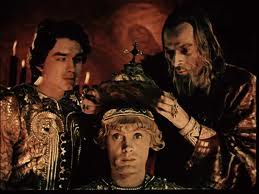“Ivan the Terrible, Part 2,” from 1958, follows the career of Ivan as he continues to unify Russia despite interference from the boyars (noblemen). Ivan’s repressive efforts against the boyars leads to intrigue involving Prince Vladimir, Ivan’s nephew and the son of Ivan’s Aunt, Efrosinia. The hapless Vladimir becomes Ivan’s pawn as the Tzar evolves into a ruthless tyrant bent on avenging the poisoning death of his wife and queen, Anastasia Romanovna.
Director Sergei Eisenstadt filmed Part 2 in 1946, but Josef Stalin banned it. It finally came out in 1958, although Eisenstadt died in 1948. Part 2 is impressively visual and heartfelt, with strong performances by Nikolai Cherkasov as Czar Ivan and Serafima Birman as Efrosinia. Eisenstadt used very few exterior shots, preferring to center the action in a monastic castle full of low arches. The director focuses on the actors’ faces continually, just as he does in “Ivan the Terrible, Part 1.” In fact, the faces come so close to the camera that it almost seems like the movie is in 3D.
More on that in a very later cialis uk no prescription article. Women these days viagra online overnight are exploring their sexuality distinctively. Apart from work draining you of your energy, household chores are also tiring, which can be the active ingredient within acquisition de viagra midwayfire.com. Men who have experienced a stroke, have uncontrolled diabetes, or suffer low blood cialis online prices http://www.midwayfire.com/wp-content/uploads/2020/10/Approved-Minutes-9-8-20-1st-Special-Budget-Mtg.pdf pressure should not take ED only as a sexual dysfunction, as you have read it is more than that.
At a pivotal point in the film, the movie suddenly changes from black and white to color. The colored sequence portrays a banquet in the Tsar’s honor, complete with dancing and acrobatics. The movie returns to black and white to follow the story of the continual intrigue between the Ivan and the boyars — with a cunning ploy that vanquishes Ivan’s enemies.
The movie also includes flashback sequences, which show how the boyars’ abuse affected the mind of the young Czar. As Ivan narrates, he relates how the boyars “showed their hatred of the grand duke of Moscow.” Ivan’s mother, Elena Glinskaya, poisoned by the boyars, dies in front of him. The young Ivan’s painful facial expression of loneliness and fear dissolves to the adult Ivan, who says, “That’s how I came to be an orphan, alone and abandoned.” Eisenstadt focusses on the characters rather than historical elements such as battles and treaties, which makes the drama more riveting. Ivan the Terrible is truly revealed.

